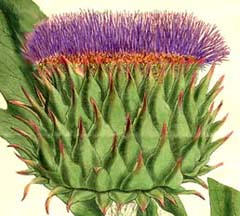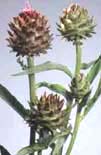|
 Cynara cardunculus Cynara cardunculus
Artichoke Thistle,
Cardoon
This huge thistle is a Mediterranean
native and the ancestor of the globe artichoke, although some consider them
to be the same species. Magickally, the thistle is, logically enough,
good for protection and a fine symbol of strength and courage in the face
of adversity. As a thorny character, it is ruled by Mars, but this
particular version has hermaphroditic flowers, so male and female aspects
are combined--which perhaps accounts for why men who carry this magick herb are supposed
to be better lovers. Dried thistles also make fine wands.
Mundane Uses
 The
flower buds of this plant are smaller than those of globe artichoke and
some people consider cardoon to have a more delicate flavor, tasting like
a cross between artichokes and celery. Like globe artichoke, cardoon
is harvested just before the buds open. They are usually boiled. The
stalks are often blanched by mounding dirt up around them or wrapping them
with leaves. They are harvested
and eaten raw in salads or cooked as a sort of celery. In Italy the
bitter raw stems are peeled and dipped in olive oil to eat. The young
leaves, especially the midribs, can also be eaten raw or cooked; the ancient
Romans favored this plant and made the leaves into salads or cooked them
like spinach. The leaves also make an anti-cholesterol tea. The
roots, which can get 6 feet long, are thick and tender and are cooked like
parsnips. The dried flowers can be used to curdle milk and make cheese,
and they are also very nice for dried display, as they are humungous thistles. Top The
flower buds of this plant are smaller than those of globe artichoke and
some people consider cardoon to have a more delicate flavor, tasting like
a cross between artichokes and celery. Like globe artichoke, cardoon
is harvested just before the buds open. They are usually boiled. The
stalks are often blanched by mounding dirt up around them or wrapping them
with leaves. They are harvested
and eaten raw in salads or cooked as a sort of celery. In Italy the
bitter raw stems are peeled and dipped in olive oil to eat. The young
leaves, especially the midribs, can also be eaten raw or cooked; the ancient
Romans favored this plant and made the leaves into salads or cooked them
like spinach. The leaves also make an anti-cholesterol tea. The
roots, which can get 6 feet long, are thick and tender and are cooked like
parsnips. The dried flowers can be used to curdle milk and make cheese,
and they are also very nice for dried display, as they are humungous thistles. Top
How to grow artichoke thistle:
Soak in room temp water overnight and then just barely
cover in moist planting medium to germinate in 14-30 days at 70-75F/21-24C. Best
started 6-8 weeks before your last frost, but if your winter
doesn't go below 14F/-10C, you can start them in fall and harvest
in spring. Transplant out after danger of frost to full sun and well drained soil 2-3 ft/60-90cm
apart. Once it's established, it is perennial to zone 6 (-10F/-23C). Frost will kill
the upper part of the plant, but the root will survive. Heat makes this
plant very bitter. It can get up to 7 ft/2m tall, although more usually it
is about 4-5 ft/1.2-1.5m tall, and the leaves, which can be very spiny, can be
3 ft/.9m long. Usually flowers its second
summer. It can grow aggressively in some areas. General growing
info.
Top
|
Cynara cardunculus
Porto Spineless Cardoon
15
seeds $3.50
This seed cannot be shipped to California.

This named variety
should germinate more uniformly and grow into a
more robust plant than the unnamed types. Its spines are blunted in
comparison with the usual artichoke thistle, but it still gets the nice
big purplish reddish thistle-type flowers.
Uses in
Witchcraft & Magick:
Protection Spells
Courage
Magick
Wands
Mars Herb
|